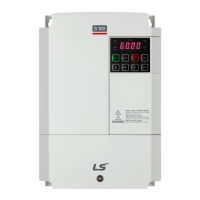• Do not use 3 core cables to connect a remotely located motor with the inverter.
• When you operating Brake resistor, the motor may vibrate under the Flux braking operation.
In this case, please turn off the Flux braking(Pr.50).
• Make sure that the total cable length does not exceed 665ft (202m). For inverters < =
4.0kW capacity, ensure that the total cable length does not exceed 165ft (50m).
• Long cable runs can cause reduced motor torque in low frequency applications due to
voltage drop. Long cable runs also increase a circuit’s susceptibility to stray capacitance
and may trigger over-current protection devices or result in malfunction of equipment
connected to the inverter.
• Voltage drop is calculated by using the following formula:
Voltage Drop (V) = [
X cable resistance (m
Ω
/m) X cable length (m) X current(A)] /
1000
• Use cables with the largest possible cross-sectional area to ensure that voltage drop is
minimized over long cable runs. Lowering the carrier frequency and installing a micro surge
filter may also help to reduce voltage drop.
Allowed Carrier Frequency
Do not connect power to the inverter until installation has been fully completed and the inverter is
ready to be operated. Doing so may result in electric shock.
• Power supply cables must be connected to the R, S, and T terminals. Connecting power
cables to other terminals will damage the inverter.
• Use insulated ring lugs when connecting cables to R/S/T and U/V/W terminals.
• The inverter’s power terminal connections can cause harmonics that may interfere with
other communication devices located near to the inverter. To reduce interference the
installation of noise filters or line filters may be required.
• To avoid circuit interruption or damaging connected equipment, do not install phase-
advanced condensers, surge protection, or electronic noise filters on the output side of the
inverter.
• To avoid circuit interruption or damaging connected equipment, do not install magnetic
contactors on the output side of the inverter.

